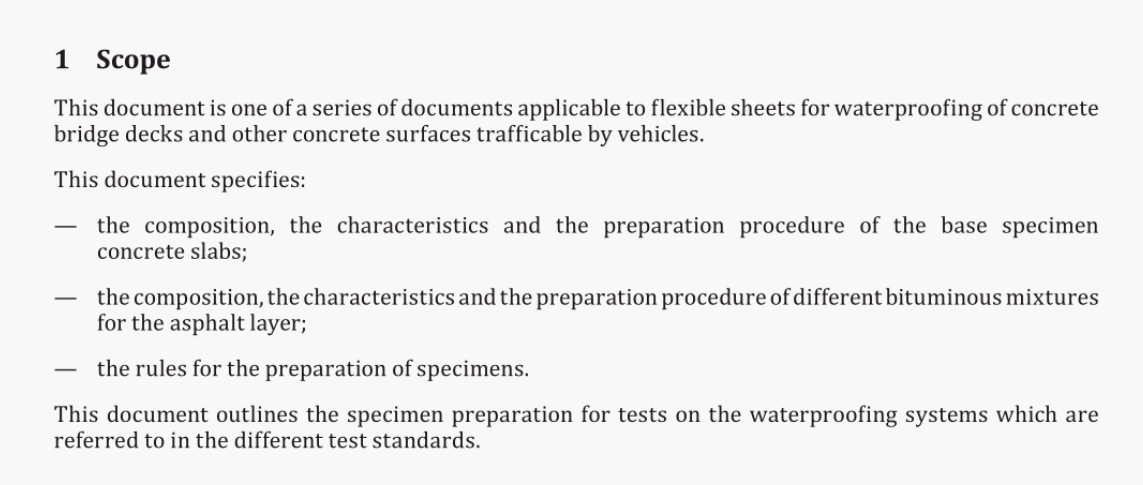BS EN 13375:2019 pdf download.Flexible sheets for waterproofing – Waterproofing of concrete bridge decks and other concrete surfaces trafficable by vehicles – Specimen preparation
1 Scope
This document is one of a series of documents applicable to flexible sheets for waterproofing of concrete bridge decks and other concrete surfaces trafficable by vehicles.
This document specifies:
– the composition, the characteristics and the preparation procedure of the base specimen concrete slabs;
– the composition, the characteristics and the preparation procedure of different bituminous mixtures for the asphalt layer;
– the rules for the preparation of specimens.
This document outlines the specimen preparation for tests on the waterproofing systems which are referred to in the different test standards.
2 Normative references
The following documents are referred to in the text in such a way that some or all of their content constitutes requirements of this document. For dated references, only the edition cited applies. For undated references, the latest edition of the referenced document (including any amendments) applies.
EN 1766:201Z, Products and systems for the protection and repair of concrete structures一Test methods一Reference concretes for testing
EN 13036-1, Road and airfield surface characteristics一Test methods一Part 1: Measurement of pavement surface macrotexture depth using a volumetric patch technique
EN 13108-1, Bituminous mixtures一Material specifications一Part 1: Asphalt Concrete
EN 13108-6, Bituminous mixtures一Material specifications一Part 6: Mastic Asphalt
EN 13108-Z Bituminous mixtures一Material specifications一Part 7: Porous Asphalt
6 Application of the waterproofing system
The waterproofing system shall be applied on base specimen concrete slabs as described in this document or in the relevant test standard. NOTE 1 To avoid the influence of vibrations during compaction, the concrete slabs can be laid on flat ground using a soft intermediate layer (e.g sand). NOTE 2 The required number of slabs is prepared according to the number of intended tests and test methods. It might be advantageous to hold them together by a stiff frame. Figure 2 gives an example of this procedure. Alternatively, the base specimens can be prepared separately for each test. The waterproofing system shall be applied in accordance with the instructions from the manufacturer. The type and amount of primer (bituminous, resin etc.) and adhesive bitumen (in the case of pour-and- roll technique system) shall be within the range defined by the manufacturer. NOTE3 For torch-on systems, it is important that a uniform welding wave is produced during application. For pour-and-roll technique systems, the temperature of the adhesive bitumen shall be checked during melting and application and shall not exceed temperature ranges recommended by the manufacturer. It is advised to pay attention not to overheat the polymer bitumen. After cooling to room temperature, the waterproofing shall be cut along the edges of the concrete slabs to obtain individual specimens to prepare for the different tests. The asphalt layer shall be applied in accordance with 7.2 of this document.
BS EN 13375:2019 pdf download
